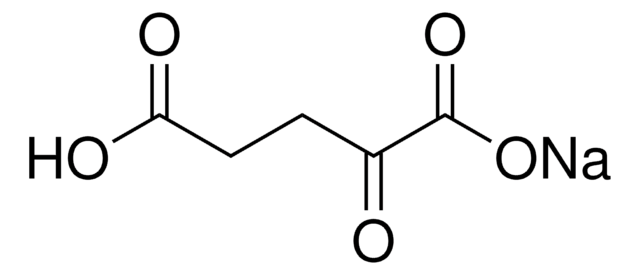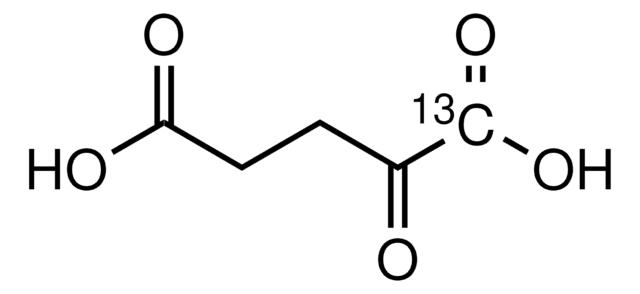K1128
α-Ketoglutaric acid
BioReagent, suitable for cell culture, suitable for insect cell culture
Synonim(y):
2-Oxoglutaric acid, 2-Oxopentanedioic acid
About This Item
Polecane produkty
linia produktu
BioReagent
Próba
≥98.5% NaOH basis (titration)
Postać
powder or crystals
metody
cell culture | insect: suitable
cell culture | mammalian: suitable
rozpuszczalność
water: 100 mg/mL, clear to slightly hazy, colorless to almost colorless
temp. przechowywania
2-8°C
ciąg SMILES
OC(=O)CCC(=O)C(O)=O
InChI
1S/C5H6O5/c6-3(5(9)10)1-2-4(7)8/h1-2H2,(H,7,8)(H,9,10)
Klucz InChI
KPGXRSRHYNQIFN-UHFFFAOYSA-N
Szukasz podobnych produktów? Odwiedź Przewodnik dotyczący porównywania produktów
Opis ogólny
Zastosowanie
- as a supplement in minimum essential medium α (α-MEM) to culture primary mesenchymal stromal/stem cells (MSCs) to study its effects on age-related osteoporosis
- for chemical treatments to compare the treatment effects of several compounds on lifespan between manual and automated lifespan machine (ALM) platforms
- as a printed chemotaxis ligand to screen chemotaxis receptors with high-throughput technologies and verify the interactions with surface plasmon resonance (SPR)
Działania biochem./fizjol.
Hasło ostrzegawcze
Danger
Zwroty wskazujące rodzaj zagrożenia
Zwroty wskazujące środki ostrożności
Klasyfikacja zagrożeń
Eye Dam. 1
Kod klasy składowania
11 - Combustible Solids
Klasa zagrożenia wodnego (WGK)
WGK 3
Temperatura zapłonu (°F)
Not applicable
Temperatura zapłonu (°C)
Not applicable
Środki ochrony indywidualnej
dust mask type N95 (US), Eyeshields, Gloves
Certyfikaty analizy (CoA)
Poszukaj Certyfikaty analizy (CoA), wpisując numer partii/serii produktów. Numery serii i partii można znaleźć na etykiecie produktu po słowach „seria” lub „partia”.
Masz już ten produkt?
Dokumenty związane z niedawno zakupionymi produktami zostały zamieszczone w Bibliotece dokumentów.
Klienci oglądali również te produkty
Nasz zespół naukowców ma doświadczenie we wszystkich obszarach badań, w tym w naukach przyrodniczych, materiałoznawstwie, syntezie chemicznej, chromatografii, analityce i wielu innych dziedzinach.
Skontaktuj się z zespołem ds. pomocy technicznej













